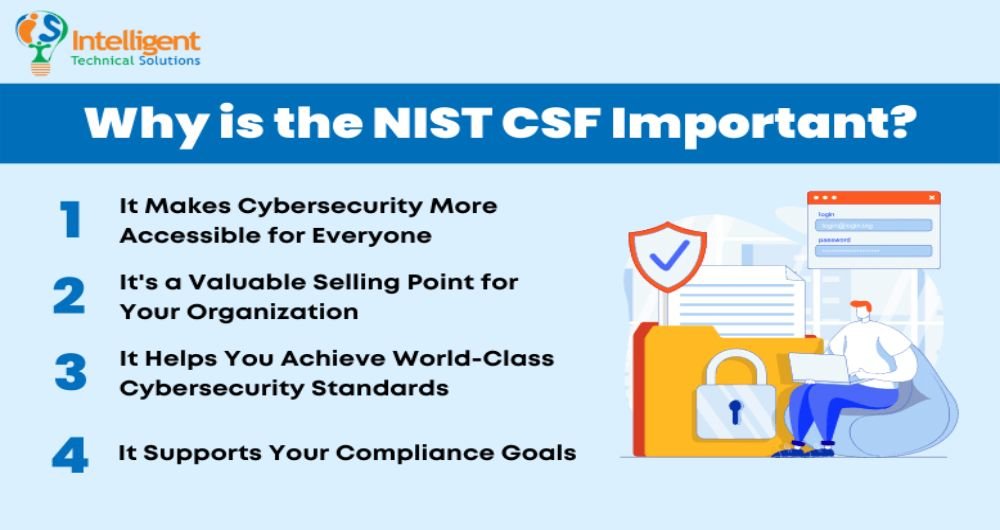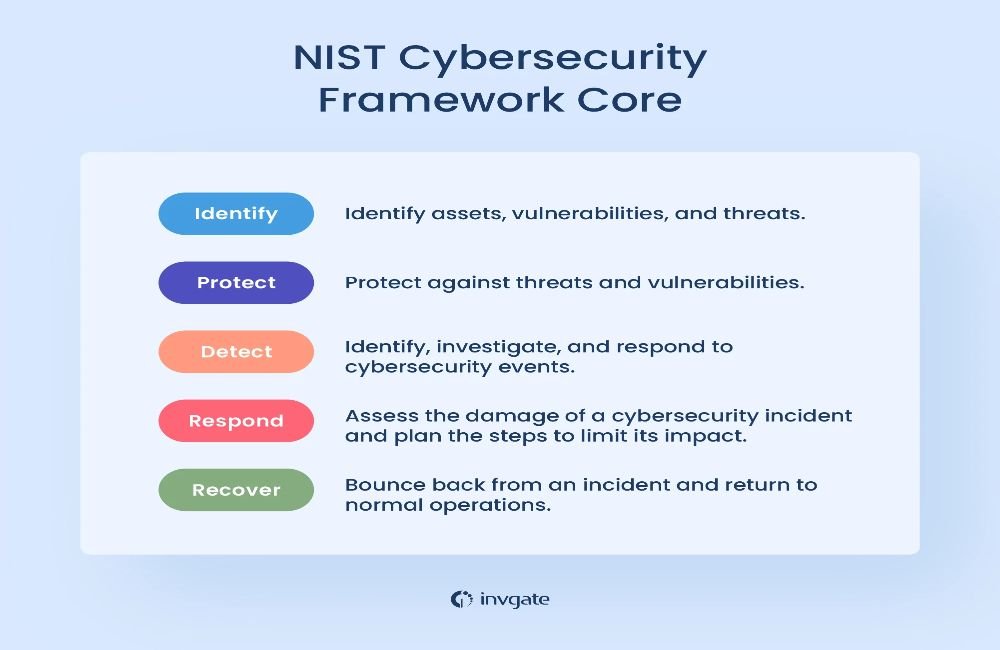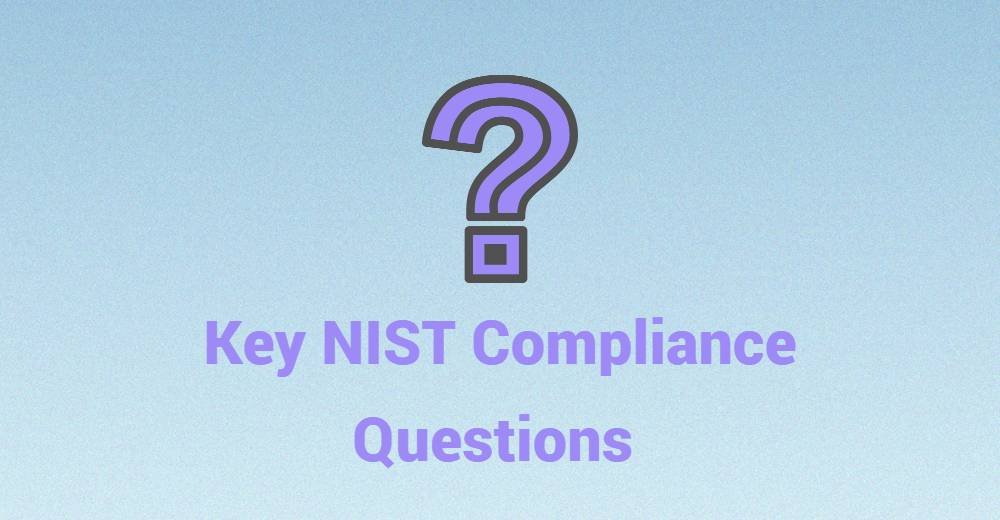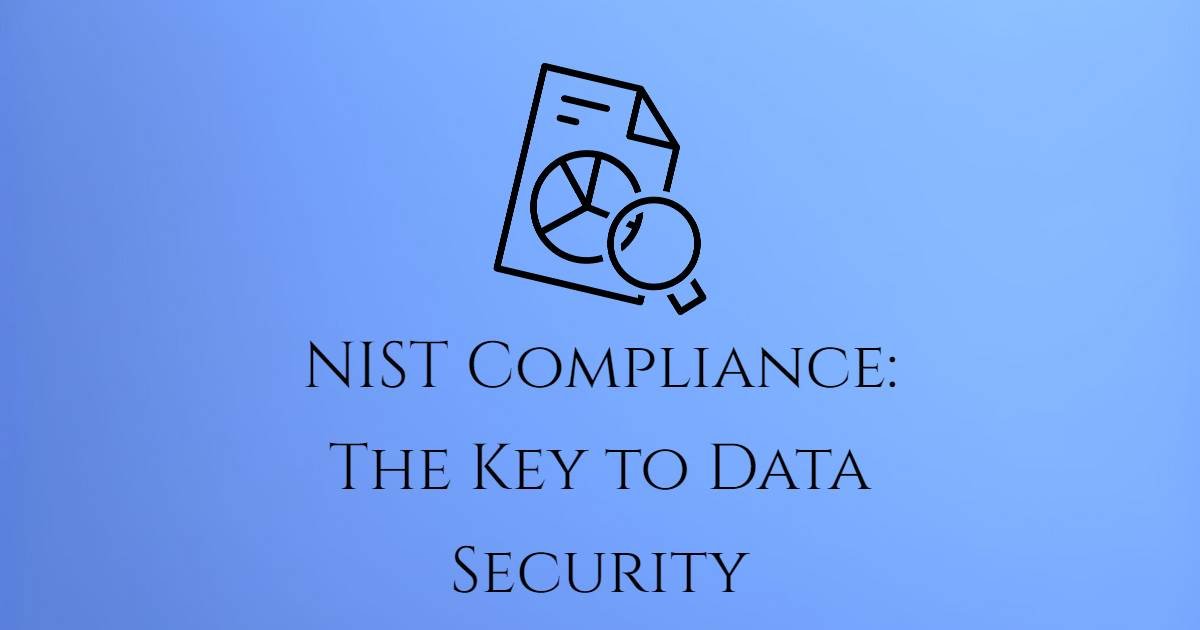NIST Compliance: The Key to Data Security
In today’s world, keeping data secure is crucial due to frequent cyber-attacks. The National Institute of Standards and Technology (NIST) offers a framework for your organizations to follow, ensuring compliance with regulations like the Health Insurance Portability and Accountability Act (HIPAA) and the Federal Information Security Management Act (FISMA).
This blog will provide essential information on NIST compliance, how it improves security measures, and the benefits of NIST compliance. We will also answer questions about NIST compliance, such as who needs to adopt it and if it is mandatory or optional. Also, I will compare it to other security standards and provide tips for achieving success. Let’s explore the world of NIST compliance!

Source: ITS
Understanding NIST Standards and its Importance
NIST is a group that sets a comprehensive set of standards for data security in the U.S. It’s essential to follow these standards and recommendations to keep sensitive information safe and strengthen cybersecurity measures for government systems. NIST guidelines provide a risk management framework, making federal systems more secure. By following NIST compliance, organizations can protect data and lower risks for national systems. They also ensure a level of uniformity in cybersecurity, which is critical to the success of your business.
The Necessity of NIST Compliance
NIST compliance is essential for government agencies and organizations handling sensitive government data. By following NIST standards, the risk of cyber threats is mitigated, and protection against data breaches and unauthorized access to government data is ensured. NIST guidelines enable adherence to security best practices, ensuring the implementation of robust measures to safeguard government information.
Not complying with NIST can have severe legal and financial consequences. Embracing NIST compliance is crucial in enhancing data security and maintaining trust.

The Role of NIST in Data Security
NIST helps with cybersecurity and promotes innovation and competitiveness. It guides on securing data and creating strong controls through its framework. Compliance with NIST standards is crucial as it ensures effective security measures are implemented to protect against cyber threats.
Compliance neans are necessary for commerce, allowing technology to work seamlessly and businesses to operate smoothly. They facilitate trade by providing a common language for industries and innovators, enabling them to work together toward more significant goals and industrial competitiveness that cut across disciplines and borders.
The Evolution of NIST Compliance and NIST Cybersecurity Framework 2.0
With technological advancements, NIST compliance has evolved to address emerging cyber threats and changing compliance requirements. The NIST Cybersecurity Framework 2.0 recent unveiling in draft form introduced updates for more robust security measures, aligning with industry best practices. Continuous improvement ensures ongoing data protection, helping organizations adapt to the evolving cybersecurity landscape.
By staying current with NIST guidelines, businesses can secure their networks, protect sensitive data, and maintain compliance with federal information security management standards.
Deciphering the NIST Cybersecurity Framework (CSF)
The NIST Cybersecurity Framework sets standards for risk management and provides a common language for security communication. The framework helps organizations identify and prioritize cybersecurity risks, select appropriate security controls, and enhance resilience against cyber threats. Many businesses follow the framework to ensure data security and compliance with federal information security standards. This improves organizations’ quality of life, economic security, and rivaliry.
The NIST Cybersecurity Framework was released in February 2014 as voluntary guidance based on existing standards and practices for critical infrastructure for organizations to improve security risk management. The NIST Cybersecurity Framework 2.0 is gaining traction and has been released in draft form. The public and numerous organizations will thoroughly review it before its final release, expected in 2024.

Source: Invgate
Key Features and Components of the NIST Framework
The NIST Framework encompasses five core functions: Identify, Protect, Detect, Respond, and Recover. It embraces a risk-based approach to cybersecurity, emphasizing continuous monitoring and assessment of security measures. Collaboration and information sharing among stakeholders are encouraged by the NIST CSF. It guides on implementing security controls and measuring their effectiveness. By incorporating these key features and components, organizations can enhance their data security and mitigate the risks associated with cyber threats.
How Does the NIST Compliance Framework Enhance Security?
The NIST Framework plays a crucial role in enhancing security. Identifying vulnerabilities and developing mitigation strategies improves visibility into cybersecurity risks and enhances incident detection capabilities. Following the framework ensures a proactive and coordinated response to cyber incidents, supporting system recovery after a breach. Compliance with NIST improves overall cybersecurity posture.
The Impact of Non-compliance with NIST
Non-compliance with NIST standards can result in heightened cybersecurity risks. Neglecting NIST guidelines may lead to data breaches and financial losses. Organizations that fail to comply may face legal and regulatory consequences. Non-compliance can also tarnish the reputation and trustworthiness of businesses. To maintain the security and integrity of sensitive data, it is essential to prioritize compliance.
NIST Compliance: Mandatory or Optional?
Is NIST certification mandatory or optional? While federal government agencies, including U.S. federal agencies, must adhere to NIST standards, private sector organizations can voluntarily adopt them. However, it is highly recommended for organizations handling sensitive data, such as contractors and subcontractors working with the federal government, to obtain NIST certification.
Doing that shows a commitment to data security. It provides a competitive advantage in the marketplace—contractors with a history of NIST non-compliance risk being excluded from future government contracts.
Who Should Adhere to NIST Compliance?
Organizations with federal data, government contractors, and industries like healthcare, finance, and defense should comply with NIST. It benefits any organization seeking to enhance data security and protect sensitive information. Small and medium-sized businesses can also benefit from implementing NIST standards.
Benefits of Adopting NIST Compliance
NIST Compliance helps organizations secure their data from cyber threats and achieve security compliance. It improves data security and reduces risks by implementing best practices for information security. Organizations can protect valuable assets by following NIST guidelines to improve data handling processes and prevent unauthorized access. Meeting compliance requirements for government partnerships opens new opportunities and ensures security compliance with FISMA and HIPAA.

Advantages Over Competitors and Improved Data Handling
Stand out from competitors by showcasing adherence to NIST standards and gaining trust from stakeholders through a commitment to NIST cybersecurity guidelines. By strengthening data handling practices, organizations can ensure the privacy and integrity of sensitive information. Implementing NIST’s security controls helps mitigate the risk of data breaches, enhancing the overall security posture.
This commitment helps streamline data handling processes and transformation goals, improving efficiencies and productivity. Embracing compliance is an excellent commitment for businesses to safeguard their financial well-being and strengthen their operations.
Comparing NIST Compliance with ISO and PCI Security Standards
NIST Compliance is a security standard that has gained widespread recognition and adoption among organizations. It provides a comprehensive framework for managing and mitigating cybersecurity risks, including guidelines for identifying, protecting, detecting, responding to, and recovering from security incidents.
When compared to other security standards like the International Organization for Standardization (ISO) 27001 or Payment Card Industry Data Security Standard (PCI DSS), It ensures the protection of controlled unclassified information (CUI) within the networks of government contractors and subcontractors.
NIST 800-171 compliance defines the practices and controls that contractors must follow when their networks store or process CUI. CUI is information created or owned by the government that is sensitive but not classified.
- ISO 27001 focuses on information security management systems
- PCI DSS emphasizes securing payment card data
- NIST Compliance offers a more flexible approach tailored to organizational needs.
- NIST Compliance covers all aspects of cybersecurity risk management.
- NIST Compliance is regularly updated to keep up with emerging threats and technologies, making it a reliable standard for modern organizations.
How to Prepare for NIST Compliance?
You can assess your cybersecurity measures and identify gaps to prepare for NIST compliance. Implement security based on NIST guidelines, conduct regular audits to measure progress, and train employees on best practices. Collaborating with experts can also ensure accurate implementation.
Best Practices for Achieving NIST Compliance
Keeping an inventory of information systems and sensitive data ensures NIST compliance and strengthens network security. Use security controls to prevent unauthorized access, and update security policies regularly following NIST guidance. Continuous monitoring helps detect potential threats, while a response plan for cybersecurity incidents is also necessary.
To enhance data security, you should follow these best practices for compliance. Seek guidance from official government organizations that set and enforce compliance standards, such as .gov websites in the United States.
Cost Implications of NIST Compliance and Breach Risk
Implementing NIST compliance can involve a substantial initial investment in infrastructure, training, and implementation. However, the long-term cost savings are significant. Businesses can avoid potential fines, penalties, and legal consequences for non-compliance by improving data security and reducing the risk of breaches. Furthermore, proactive implementation of NIST guidelines helps minimize the financial impact of cybersecurity incidents.

What are the 5 standards of NIST?
The 5 standards of NIST are essential for ensuring data security. They include Identify, Protect, Detect, Respond, and Recover. These standards help organizations understand risks, safeguard systems, monitor for incidents, and respond to security breaches effectively.
Who is required to be NIST compliant?
NIST compliance is typically required for organizations handling sensitive data, including government agencies, contractors, and those working with government entities. Private sector companies may also adopt NIST guidelines as a best practice for data security. Could you check relevant regulations to determine if it’s mandatory for your organization?
How Can Businesses Ensure Ongoing NIST Compliance?
To ensure ongoing NIST compliance, your business should establish a cybersecurity awareness and accountability culture, conduct regular assessments to identify improvement areas, stay updated with the latest NIST guidelines, engage with industry experts, and continuously monitor and evaluate the effectiveness of implemented security measures.
Final Thought about NIST Compliance
So, NIST compliance is crucial for data security and protecting sensitive information. Adherence to the NIST framework enhances security measures and prevents potential threats. Non-compliance can have serious consequences, including data breaches and financial losses.
Organizations must understand the necessity of compliance and take proactive steps to implement it. Adhering to NIST meets regulatory requirements and provides a competitive edge and improved data handling capabilities. Ongoing compliance efforts ensure long-term data security and customer trust.
